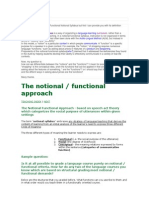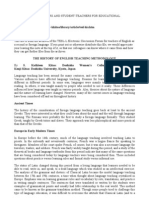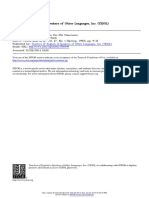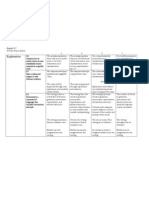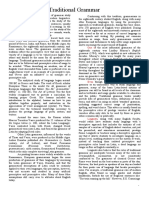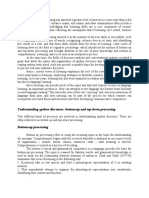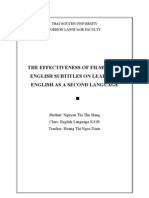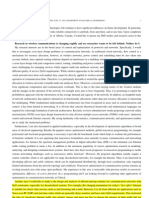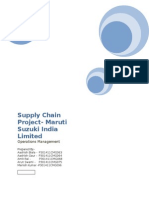100%(1)100% found this document useful (1 vote)
466 viewsEnglish For Specific Purposes: Framework For Needs Analysis Mphil Linguistics &tesol
The document discusses Munby's framework for needs analysis, which uses a Communication Needs Processor (CNP) to establish a profile of learners' communication needs based on parameters like purpose, setting, interaction level, and target proficiency. It also outlines Hutchinson and Waters' framework which involves asking questions about why, how, what, who, where, and when language is needed in the target situation. Munby's CNP remains a predominant element in his approach for conducting a thorough needs analysis.
Uploaded by
GACopyright
© © All Rights Reserved
Available Formats
Download as PDF, TXT or read online on Scribd
100%(1)100% found this document useful (1 vote)
466 viewsEnglish For Specific Purposes: Framework For Needs Analysis Mphil Linguistics &tesol
The document discusses Munby's framework for needs analysis, which uses a Communication Needs Processor (CNP) to establish a profile of learners' communication needs based on parameters like purpose, setting, interaction level, and target proficiency. It also outlines Hutchinson and Waters' framework which involves asking questions about why, how, what, who, where, and when language is needed in the target situation. Munby's CNP remains a predominant element in his approach for conducting a thorough needs analysis.
Uploaded by
GACopyright
© © All Rights Reserved
Available Formats
Download as PDF, TXT or read online on Scribd
You are on page 1/ 21
English for Specific Purposes
Framework for Needs Analysis
MPhil Linguistics &TESOL
Shabana Ahmed
School of Education
Beaconhouse National University
shabana.ahmed@bnu.edu.pk
Munby’s Framework of Needs
Analysis
• Munby’s Communicative Syllabus Design set
functions and situations within the framework
of needs analysis.
• He introduced communication needs processor
(CPN) which provided a framework for analysing
communication needs of the learners.
• It placed the learner’s purposes in the central
position within the framework of needs analysis
Munby’s Framework of Needs
Analysis
• The concept of target needs became
paramount
• Subsequent research proved that function and
situation were also fundamental.
Munby’s Framework of Needs
Analysis
With the development of the CNP it seemed
as if ESP had come of age. The machinery for
identifying the needs of any group of learners
had been provided: all the course designers
had to do was to operate it.
Hutchinson and Waters (1987: 54)
Munby’s Framework of Needs
Analysis
• In Munby’s framework, the target needs and
target level performance are established by
investigating the target situation.
• In the CNP, account is taken of “the variables
that affect communication needs by
organizing them as parameters in a dynamic
relationship to each other” (Munby cited in
Songhori, 208, p. 32).
Elements of Munby’s Framework
1. Participants
• Information about the identity and language of
the learners: age, sex, nationality, present
command of target language, other languages
known and extent of command.
2. Communication Needs Processor
• Investigates the particular communication needs
according to sociocultural and stylistic variables
which interact to determine a profile of such
needs.
Elements of Munby’s Framework
3. Profile of Needs
• Is established through the processing of data
in the CNP.
4. Meaning Processor
• Parts of the socioculturally determined profile
of communication needs are converted into
semantic subcategories of a predominantly
pragmatic kind.
Elements of Munby’s Framework
5. The Language Skills Selector
• Identifies the specific language skills that are
required to realize the events or activities that
have been identified in the CNP.
6. The Linguistic Encoder
• Considers the dimension of contextual
appropriacy.
Elements of Munby’s Framework
7. The Communicative Competence
Specification
• Indicates the target communicative
competence of the participant and is the
translated profile of needs.
Elements of Munby’s Framework
• The predominant or the most frequently referred
to element of Munby’s Model is the
Communication Needs Processor (CNP) which is
the basis of Munby’s approach to needs analysis.
• It establishes the profile of needs through the
processing of eight parameters.
• The processing of these parameters gives us a
detailed description of particular communication
needs.
Parameters of Munby’s CNP
Munby’s CNP includes the processing of eight
parameters:
1. Purposive domain: establishes the type of
discipline, and then the purpose which the target
language will be used for at the end of the course
2. Setting: the physical setting of the situation
where English will be used, and the psychological
setting specifying the different environment in
which English will be used.
Parameters of Munby’s CNP
3. Interaction: identifies the learner’s
interlocutors and predicts relationship
between them
4. Instrumentality: specifies the medium,
mode, and channel of communication, i.e.,
whether it is face to face, radio, or any other.
5. Dialect: dialects learners will have to
understand or produce in terms of their
spatial, temporal, or social aspect
Parameters of Munby’s CNP
6. Communicative event: states what the
participants will have to do productively or
receptively.
7. Communicative key: the manner in which the
participants will have to do the activities
comprising an event, e.g. politely or impolitely.
8. Target level: level of linguistic proficiency at the
end of the ESP course which might be different for
different skills.
A needs analysis based on Munby’s Communication Needs
Processor (cited in Hutchinson & Waters, 1987)
Sample Communication Related ‘Micro-Function Language Form
Activity
Attending to customer’s 1. intention I will bring the menu
arrival 2. prohibit I’m afraid we’re
full/closed
3. direct Please follow me
Will you sit here please
Attending to customer’s 1 . suggestive May I suggest
the .....?
order 2. advise May I recommend the
…?
3. describe You may find …too
hot/spicy.
Serving the order 1. question Is …for you,
sir/madam?
Hutchinson and Waters’ Framework
for Needs Analysis
• For some researchers, the analysis of target
situation needs is “in essence a matter of
asking questions about the target situation
and the attitudes towards that situation of
various participants in the learning process”
(Hutchinson & Waters, 1987, p. 59).
Hutchinson and Waters’ Framework
for Needs Analysis
Why is the language needed?
• For work
• For study
• For a training
• For a combination of these
• For some other purpose (status, exams,
promotion)
Hutchinson and Waters’ Framework
for Needs Analysis
How will the language be used?
• Medium: speaking, reading, writing
• Channel: telephone, face to face
• Types of text or discourse: academic texts,
lecture, informal conversation, technical
manuals, catalogues
Hutchinson and Waters’ Framework
for Needs Analysis
What will the content areas be?
• Subjects: medicine, biology, architecture
• Level: technician, craftsman, postgraduate,
secondary school
Hutchinson and Waters’ Framework
for Needs Analysis
Who will learners use the language with?
• Native or non-native speakers
• Level of knowledge of receiver: layman,
expert, student
• Relationship: colleague, teacher, customer,
subordinate
Hutchinson and Waters’ Framework
for Needs Analysis
Where will the language be used?
• Physical setting: office, lecture hall, library, hotel
• Human context: alone, meetings, on the phone
• Linguistic context: own country, abroad
Hutchinson and Waters’ Framework
for Needs Analysis
When will the language be used?
• Concurrently with the ESP course or
subsequently
• Frequently, seldom, in large amounts, chunks
You might also like
- Communicative Syllabus Design: Patricia A. PorterNo ratings yetCommunicative Syllabus Design: Patricia A. Porter22 pages
- 28 Fresh ESL Vocabulary Words For SpringNo ratings yet28 Fresh ESL Vocabulary Words For Spring4 pages
- The History of English Language Teaching Methodology Short Article100% (2)The History of English Language Teaching Methodology Short Article4 pages
- Written Report (Models of Needs Analysis in Esp)100% (1)Written Report (Models of Needs Analysis in Esp)3 pages
- Formative Assessment Activities and TechniquesNo ratings yetFormative Assessment Activities and Techniques1 page
- The Role of Pragmatics in Second Language Teaching PDFNo ratings yetThe Role of Pragmatics in Second Language Teaching PDF63 pages
- Current Perspectives On Teaching The Four SkillsNo ratings yetCurrent Perspectives On Teaching The Four Skills24 pages
- Adaptation For Struggling Writers: Remedial Instruction For Reading and WritingNo ratings yetAdaptation For Struggling Writers: Remedial Instruction For Reading and Writing27 pages
- Lexical Elaboration and Linguistic ExpressionNo ratings yetLexical Elaboration and Linguistic Expression6 pages
- Assessing Vocabulary in The Language ClassroomNo ratings yetAssessing Vocabulary in The Language Classroom7 pages
- PSY 369: Psycholinguistics: Language and The BrainNo ratings yetPSY 369: Psycholinguistics: Language and The Brain41 pages
- THE TEACHING AND ASSESSMENT IN READING - OutlineNo ratings yetTHE TEACHING AND ASSESSMENT IN READING - Outline3 pages
- Module 1 Stylistics and Discourse AnalysisNo ratings yetModule 1 Stylistics and Discourse Analysis8 pages
- Reexamining English Only in The ESL ClassroomNo ratings yetReexamining English Only in The ESL Classroom25 pages
- Dyna Ariyani-Improving Students' Pronunciation by Using Reading Aloud in Junior High SchoolNo ratings yetDyna Ariyani-Improving Students' Pronunciation by Using Reading Aloud in Junior High School9 pages
- Sem119 - Teaching and Assessment of Literature StudiesNo ratings yetSem119 - Teaching and Assessment of Literature Studies18 pages
- Bilingual Approaches To Language Learning: (Mary Mcgroarty)No ratings yetBilingual Approaches To Language Learning: (Mary Mcgroarty)34 pages
- A Critical Analysis of Krashen's Monitor Theory100% (1)A Critical Analysis of Krashen's Monitor Theory16 pages
- Using Local Languages in English Language ClassroomsNo ratings yetUsing Local Languages in English Language Classrooms5 pages
- Language, Culture and Society Syllabus DGP100% (1)Language, Culture and Society Syllabus DGP11 pages
- Expressive Means and Stylistic Devices. Phonetic and Graphical Expressive Means and Stylistic DevicesNo ratings yetExpressive Means and Stylistic Devices. Phonetic and Graphical Expressive Means and Stylistic Devices13 pages
- Understanding Spoken Discourse: Bottom-Up and Top-Down ProcessingNo ratings yetUnderstanding Spoken Discourse: Bottom-Up and Top-Down Processing5 pages
- The Effectiveness of Films With English Subtitles On Learning English As A Second LanguageNo ratings yetThe Effectiveness of Films With English Subtitles On Learning English As A Second Language9 pages
- 2.2. Models To Teaching Literature: Information-Based Approach Teacher-CentredNo ratings yet2.2. Models To Teaching Literature: Information-Based Approach Teacher-Centred4 pages
- Krashen's Input Hypothesis and English Classroom TeachingNo ratings yetKrashen's Input Hypothesis and English Classroom Teaching4 pages
- Assessment and Testing in English For SPNo ratings yetAssessment and Testing in English For SP6 pages
- BSEE 21 (Introduction To Linguistics) Course SyllabusNo ratings yetBSEE 21 (Introduction To Linguistics) Course Syllabus3 pages
- The Acquisition of Sociolinguistic Competence in a Lingua Franca ContextFrom EverandThe Acquisition of Sociolinguistic Competence in a Lingua Franca ContextNo ratings yet
- Role of Needs Analyses in ESP Course Design: PH.D Coursework Paper-2No ratings yetRole of Needs Analyses in ESP Course Design: PH.D Coursework Paper-217 pages
- Qualitative Research Methodology: PhenomenologyNo ratings yetQualitative Research Methodology: Phenomenology12 pages
- English For Specific Purposes Mphil Linguistics and TesolNo ratings yetEnglish For Specific Purposes Mphil Linguistics and Tesol42 pages
- Unit - 4 Artificial Intelligence AssignmentNo ratings yetUnit - 4 Artificial Intelligence Assignment13 pages
- Comprehensive Systematic Review On Virtual Reality For Cultural Heritage Practices Coherent Taxonomy and MotivationsNo ratings yetComprehensive Systematic Review On Virtual Reality For Cultural Heritage Practices Coherent Taxonomy and Motivations17 pages
- Techniques For The Seismic Rehabilitation of Existing BuildingsNo ratings yetTechniques For The Seismic Rehabilitation of Existing Buildings167 pages
- (Extended) Roll Me A Deity - by Assassin NPCNo ratings yet(Extended) Roll Me A Deity - by Assassin NPC35 pages
- Tvsram Email: Tvsram@sac - Ernet.in: VHDL Basics byNo ratings yetTvsram Email: Tvsram@sac - Ernet.in: VHDL Basics by64 pages
- Ear Lobe Patterns Comparison Among Males and Females of Madhya PradeshNo ratings yetEar Lobe Patterns Comparison Among Males and Females of Madhya Pradesh6 pages
- The Colonial Origin of The Social SciencesNo ratings yetThe Colonial Origin of The Social Sciences5 pages
- Typhoon Yolanda: An Analysis On The Impact of Natural Disasters and Effectiveness of Disaster ManagementNo ratings yetTyphoon Yolanda: An Analysis On The Impact of Natural Disasters and Effectiveness of Disaster Management7 pages
- English Sheet Test 3, 5 & 9 10.04.25 Home WorkNo ratings yetEnglish Sheet Test 3, 5 & 9 10.04.25 Home Work5 pages
- Manual de Instalare Unitate de Control Umirs QuadroSenseNo ratings yetManual de Instalare Unitate de Control Umirs QuadroSense26 pages
- The History of English Language Teaching Methodology Short ArticleThe History of English Language Teaching Methodology Short Article
- The Role of Pragmatics in Second Language Teaching PDFThe Role of Pragmatics in Second Language Teaching PDF
- Adaptation For Struggling Writers: Remedial Instruction For Reading and WritingAdaptation For Struggling Writers: Remedial Instruction For Reading and Writing
- PSY 369: Psycholinguistics: Language and The BrainPSY 369: Psycholinguistics: Language and The Brain
- Dyna Ariyani-Improving Students' Pronunciation by Using Reading Aloud in Junior High SchoolDyna Ariyani-Improving Students' Pronunciation by Using Reading Aloud in Junior High School
- Sem119 - Teaching and Assessment of Literature StudiesSem119 - Teaching and Assessment of Literature Studies
- Bilingual Approaches To Language Learning: (Mary Mcgroarty)Bilingual Approaches To Language Learning: (Mary Mcgroarty)
- Using Local Languages in English Language ClassroomsUsing Local Languages in English Language Classrooms
- Expressive Means and Stylistic Devices. Phonetic and Graphical Expressive Means and Stylistic DevicesExpressive Means and Stylistic Devices. Phonetic and Graphical Expressive Means and Stylistic Devices
- Understanding Spoken Discourse: Bottom-Up and Top-Down ProcessingUnderstanding Spoken Discourse: Bottom-Up and Top-Down Processing
- The Effectiveness of Films With English Subtitles On Learning English As A Second LanguageThe Effectiveness of Films With English Subtitles On Learning English As A Second Language
- 2.2. Models To Teaching Literature: Information-Based Approach Teacher-Centred2.2. Models To Teaching Literature: Information-Based Approach Teacher-Centred
- Krashen's Input Hypothesis and English Classroom TeachingKrashen's Input Hypothesis and English Classroom Teaching
- BSEE 21 (Introduction To Linguistics) Course SyllabusBSEE 21 (Introduction To Linguistics) Course Syllabus
- The Acquisition of Sociolinguistic Competence in a Lingua Franca ContextFrom EverandThe Acquisition of Sociolinguistic Competence in a Lingua Franca Context
- Role of Needs Analyses in ESP Course Design: PH.D Coursework Paper-2Role of Needs Analyses in ESP Course Design: PH.D Coursework Paper-2
- English For Specific Purposes Mphil Linguistics and TesolEnglish For Specific Purposes Mphil Linguistics and Tesol
- Comprehensive Systematic Review On Virtual Reality For Cultural Heritage Practices Coherent Taxonomy and MotivationsComprehensive Systematic Review On Virtual Reality For Cultural Heritage Practices Coherent Taxonomy and Motivations
- Techniques For The Seismic Rehabilitation of Existing BuildingsTechniques For The Seismic Rehabilitation of Existing Buildings
- Tvsram Email: Tvsram@sac - Ernet.in: VHDL Basics byTvsram Email: Tvsram@sac - Ernet.in: VHDL Basics by
- Ear Lobe Patterns Comparison Among Males and Females of Madhya PradeshEar Lobe Patterns Comparison Among Males and Females of Madhya Pradesh
- Typhoon Yolanda: An Analysis On The Impact of Natural Disasters and Effectiveness of Disaster ManagementTyphoon Yolanda: An Analysis On The Impact of Natural Disasters and Effectiveness of Disaster Management
- Manual de Instalare Unitate de Control Umirs QuadroSenseManual de Instalare Unitate de Control Umirs QuadroSense




